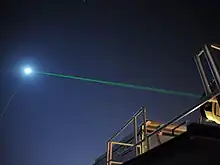MoonLIGHT (Moon Laser Instrumentation for General relativity High accuracy Tests) is a laser retroreflector developed as a collaboration primarily between the University of Maryland in the United States, and the Italian National Institute for Nuclear Physics - National Laboratories of Frascati (INFN-LNF) to complement and expand on the Lunar Laser Ranging experiment started with the Apollo Program in 1969. MoonLIGHT was planned to be launched in July 2020 as a secondary payload on the MX-1E lunar lander built by the private company Moon Express. However, as of February 2020, the launch of the MX-1E has been canceled. In 2018 INFN proposed to the European Space Agency (ESA) the MoonLIGHT Pointing Actuators (MPAc) project and was contracted by ESA to deliver it. MPAc is an INFN development for ESA, with auxiliary support by the Italian Space Agency (ASI) for prototyping work. In 2021, ESA agreed with NASA to launch MPAc with a Commercial Lunar Payload Services (CLPS) mission. Nova-C, the lander on which MPAc will be integrated, is designed by Intuitive Machines and the landing site is Reiner Gamma. The launch expected date is in 2024.
Overview


Laser Ranging is a technique used to perform accurate precision distance measurements between a laser and an optical target, called retroreflector. Since 1969, it is possible to perform Lunar Laser Ranging (LLR) measurements thanks to the Cube Corner Retroreflector (CCR) arrays placed on the lunar surface by the Apollo and Luna missions. The principle of this laser ranging is based on laser pulses sent from a telescope on Earth to the retroreflector array on the Moon. The retroreflector (mirrors) send the pulse straight back to the originating telescope where the round trip time—and therefore the exact distance—is recorded. The reflector arrays are designed to allow more accurate measurements from Earth that will increase lunar mapping accuracy, will test principles of Einstein's general theory of relativity, and other theories of gravity. Researchers think these studies may also help understand the nature of dark energy.[1][2]
MoonLIGHT is a single 100 mm-large CCR developed as a collaboration primarily between the University of Maryland and the Italian National Institute for Nuclear Physics - National Laboratories of Frascati (INFN-LNF) .[1] Additional partners and collaborators include the Italian Space Agency's Matera Laser Ranging Observatory, as well as others laser ranging observatories and research institutes.[1] The experiment and agreement between the collaborators was announced on 15 May 2015.[1]
The reflector was planned to be a secondary payload on the MX-1E lunar lander built by Moon Express,[3] which was planned to be launched in 2020 with an Electron rocket.[3] An unrelated planned science payload on the same lander was the International Lunar Observatory.[4] The MX-1E lander was planned to land on the Malapert Mountain, a 5 km tall peak in the Aitken Basin region that has an uninterrupted direct line of sight to Earth.[5] The launch contract between Moon Express and Rocket Lab (manufacturer of Electron) was canceled sometime before February 2020. Moon Express does not, as of February 2020, anymore plan to launch MX-1E on an Electron rocket, thus leaving MX-1E and all its science payloads without a carrier rocket.[6]
In 2018 INFN proposed to ESA the MoonLIGHT Pointing Actuators (MPAc) project, able to perform unmanned pointing operation of MoonLIGHT, on the contrary to the Apollo CCR arrays that were manually arranged by the astronauts. In 2019 ESA chose MPAc among 135 eligible scientific project proposals and, in 2021, ESA agreed with NASA to launch MPAc with a Commercial Lunar Payload Services (CLPS) mission. Nova-C, the lander on which MPAc will be integrated, is designed by Intuitive Machines and the launch expected date is in early 2024.[7][8][9] The landing site is Reiner Gamma, a lunar swirl on the western edge of the Moon, as seen from Earth.
This experiment will complement and advance the retroreflector experiments begun with Apollo 11 in 1969.[1] The team claims to have developed a new approach and technology that would improve the ranging accuracy up to a factor of 100[2] (thus at a millimeter level) by using new technology and methods to correct for libration and the thermal behavior and the optical performance.[10]
See also
References
- 1 2 3 4 5 Tune, Lee (10 June 2015). "UMD, Italy & MoonEx Join to Put New Laser-Reflecting Arrays on Moon". UMD Right Now. University of Maryland. Archived from the original on 22 March 2018. Retrieved 21 March 2018.
- 1 2 Currie, Douglas; Dell'Agnello, Simone; Delle Monache, Giovanni (April–May 2011). "A Lunar Laser Ranging Retroreflector Array for the 21st Century". Acta Astronautica. 68 (7–8): 667–680. Bibcode:2011AcAau..68..667C. doi:10.1016/j.actaastro.2010.09.001.
- 1 2 Boyle, Alan (12 July 2017). "Moon Express unveils its roadmap for giant leaps to the lunar surface ... and back again". GeekWire. Retrieved 15 March 2018.
- ↑ "Moon Express Announces Lunar South Pole Mission Technology Development Contract with International Lunar Observatory Association" (Press release). Moon Express. 21 July 2017. Archived from the original on 20 March 2018. Retrieved 21 March 2018.
- ↑ Nowakowski, Tomasz (12 August 2017). "International Lunar Observatory to offer a new astrophysical perspective". Spaceflight Insider.
- ↑
- Moon Express [@MoonEx] (February 9, 2020). "There is no upcoming launch with RocketLab. We contracted with RocketLab back in 2015 for a GLXP attempt. We are currently focused on efforts supporting NASA under our Commercial Lunar Payload Services (CLPS) contract" (Tweet). Retrieved 26 February 2020 – via Twitter.
- ↑ "NASA Selects Intuitive Machines for New Lunar Science Delivery".
- ↑ "NASA Selects Intuitive Machines to Deliver 4 Lunar Payloads in 2024". 17 November 2021.
- ↑ "NASA Payloads for (CLPS PRISM) CP-11 – Intuitive Machines Nova-C Lander".
- ↑ "MoonLIGHT: A USA–Italy lunar laser ranging retroreflector array for the 21st century." M. Martini, S. Dell'Agnello, D. Currie, G. Delle Monache, R. Vittori, J.F. Chandler, C. Cantone, A. Boni, S. Berardi, G. Patrizi, M. Maiello, M. Garattini, C. Lops, R. March, G. Bellettini, R. Tauraso, N. Intaglietta, M. Tibuzzi, etal. Planetary and Space Science. Volume 74, Issue 1, December 2012, Pages 276-282. doi:10.1016/j.pss.2012.09.006.